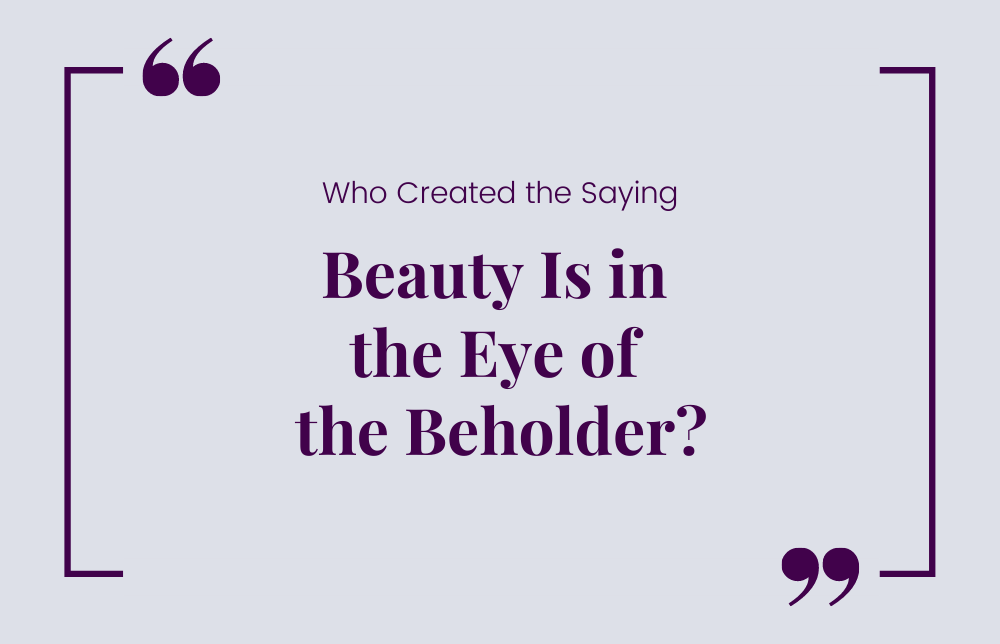
Who Created the Saying 'Beauty Is in the Eye of the Beholder'?
February 1, 2022
With Valentine's Day coming up, we often turn our gaze to our loved ones. But what we see is up to us. One of the most universally celebrated phrases about the nature of love and appreciation is “Beauty is in the eye of the beholder”. But where did that phrase originate?
It’s one of the most universally celebrated phrases about the nature of love and appreciation. But where did the saying “Beauty is in the eye of the beholder” originate?
'Beauty in the eye of the beholder' has a literal meaning: that the perception of beauty is subjective - people can have differing opinions on what is beautiful. So what one person perceives as flawless and captivating might be ordinary or unappealing to another.
What's the origin of the phrase 'Beauty is in the eye of the beholder'?
The concept that each individual has a different inclination of what is beautiful first appeared in the 3rd century BC in Greek. According to Plato, the sense of beauty is itself transient in nature. So, a thing beautiful for one might not be beautiful for the other.
Philosophers continued to grapple with the question of the question whether beauty was objective or subjective for centuries. On the side of beauty being a subjective matter, many expressed sentiments similar to Plato, and plenty of variations on his statement followed.
One example is found in English playwright John Lyly's late 16th century play, Euphues and his England:
"...as neere is Fancie to Beautie, as the pricke to the Rose, as the stalke to the rynde, as the earth to the roote."
A similar sentiment was eloquently expressed by Shakespeare in Love’s Labor Lost:
“Beauty is bought by judgement of the eye,
Not utter'd by base sale of chapmen's tongues”
Even Founding Father Benjamin Franklin paralleled the sentiment in Poor Richard's Almanack, 1741, writing:
“Beauty, like supreme dominion
Is but supported by opinion”
And, just a year later, David Hume penned:
"Beauty in things exists merely in the mind which contemplates them."
The modern-day version of the expression is believed to have first appeared in English in the 19th century. Margaret Wolfe Hungerford (née Hamilton) is widely credited with coining the saying in its current form. Hungerford wrote many books, often under the pseudonym of 'The Duchess'. In the 1878 novel Molly Bawn, there's the line "It is an old axiom, and well said, that “beauty is in the eye of the beholder".
This subjective nature of beauty applies in all areas of our lives: from art, literature, music, and, of course, love. It is this matter of perception that allow for differences in opinion and grant us the ability to see and appreciate things that others may overlook.
Seeing loved ones in a special way is healthy, but making sure your vision stays healthy with regular check-ups is important. IRTA and AMBA have a Vision Plan that covers everything from checkups to new eyewear and prescription lenses and more. Sign up now at www.AMBAdentalvision.com or call 866-979-0497.
RECENT POSTS
An Ambulance Trip Is Stressful: With MASA, the Cost Doesn’t Have to Be
People who require an emergency ambulance trip frequently ask the same question upon receiving the bill: “Why was the
Read More
AMBA’s Essential Insights in Dental Health: Understanding Cavities
Have you ever experienced pain or noticed persistent sensitivity in your teeth? You might have a cavity. Cavities are common,
Read More
Keep “Looking” Your Best: The Unique Eye Health Challenges for Women Over 55
March is Women’s History Month, a time to celebrate women's contributions to American history and society. It’s
Read More

Leaving Your Home To A Loved One
If you’re like many people, your home represents more than just financial value. As the saying goes, "Home is where the
Read More

